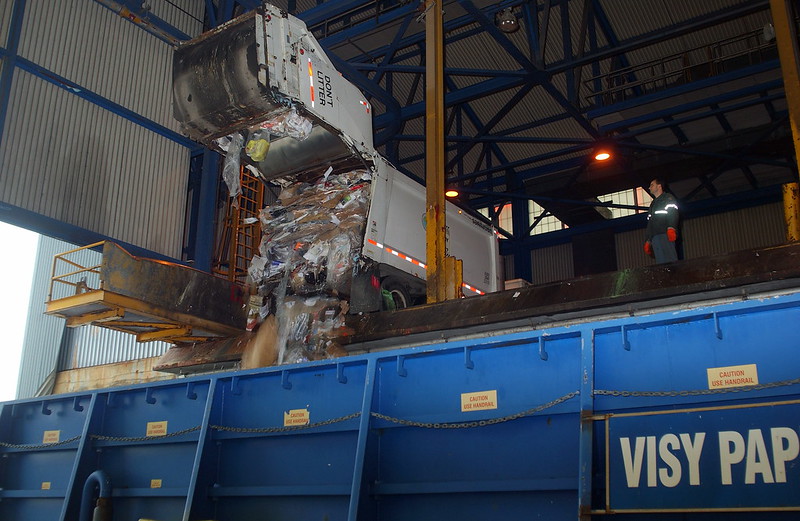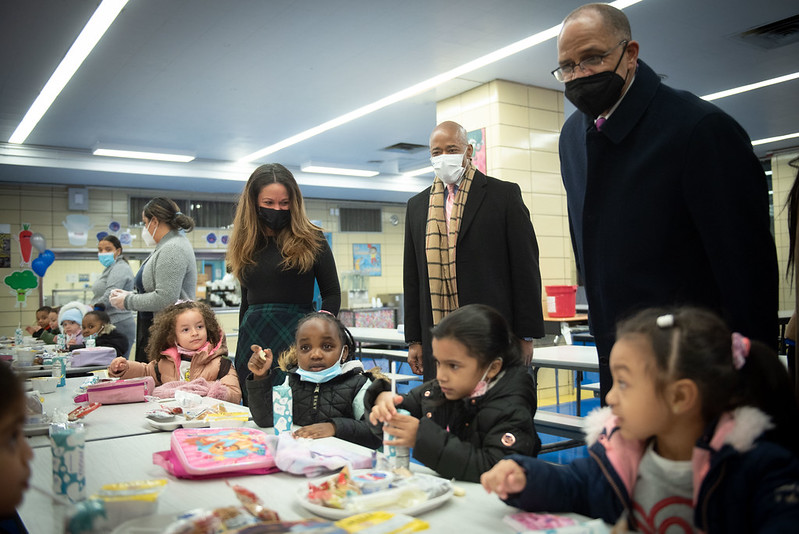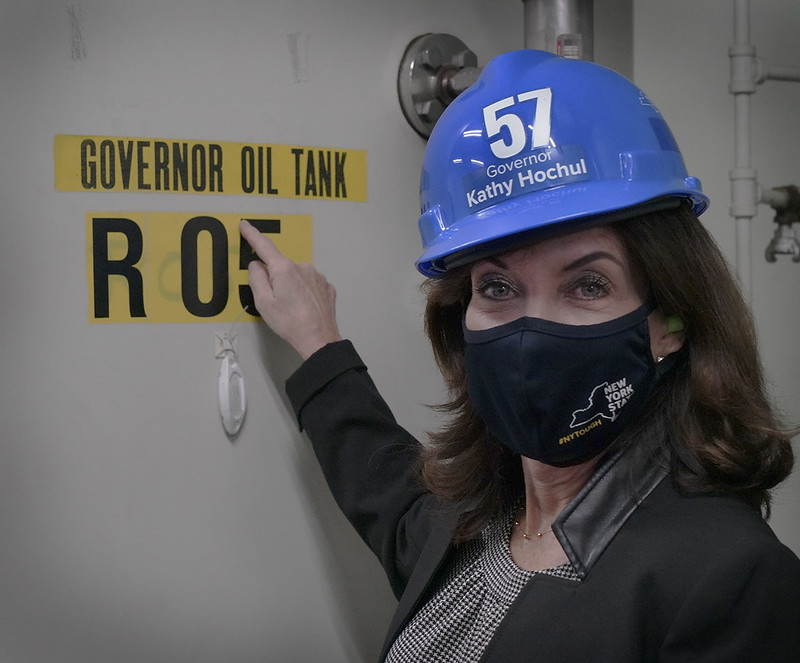Letter To The Editor: Papering Over Recycling Success

Paper recycling (photo: Michael Anton/NY City Department of Sanitation))
To the Editor:
The March 28, 2022 column, “For the Earth, It’s Essential New York Leaders Pass Extended Producer Responsibility,” by New York League of Conservation Voters President Julie Tighe misses the mark by urging lawmakers in Albany to pass an Extended Producer Responsibility (EPR) policy. State legislators should pursue a more deliberative approach to consider New York’s paper recycling achievements, and EPR’s potential adverse effects, rather than rush to include a one-size-fits-all policy approach, which could disrupt successful paper recycling.
The paper industry is a leader when it comes to recycling. Thanks to billions of dollars in private investments, the paper industry recycles over 50 million tons of recovered paper annually – totaling more than 1 billion tons over the past two decades. In fact, more paper by weight is recycled from municipal waste streams than plastic, glass, steel, and aluminum combined. Our industry has already committed approximately $5 billion in manufacturing investments by 2023 to continue the best use of recycled fibers in our products – that’s nearly $2.5 million per day in sustainability investments.
Our paper recovery rates have risen and stayed at or near historically high levels without regulatory intervention. For example, the recycling rate for cardboard – the paper material most likely impacted by EPR policies – is nearly 89%. In New York, almost 90% of residents have access to curbside paper recycling. These are outstanding figures EPR policies would not likely improve.
Reducing landfill waste, curbing pollution, and addressing our changing climate are critically important environmental goals. EPR could jeopardize already effective paper recycling and create additional economic challenges. EPR expenses imposed on paper producers could also risk increasing costs on everyday items for consumers, and impact our industry’s 28,000 New York employees, who work in 224 facilities across the Empire State – jobs that meet $1.69 billion in annual payroll and generate $211 million in estimated state and local taxes.
Our New York paper industry and its products are part of the recycling solution. Our investments in recycling infrastructure and the wide availability of recycling programs continue to play a key role in paper recycling achievements. State representatives should use this real-world success as a road map for improving recycling rates, not impede successful paper recycling programs or create hardship for constituents.
Sincerely,
Eric Steiner
Vice President of Government Affairs, American Forest & Paper Association (AF&PA)
On Twitter @ForestandPaper
***
Have an op-ed idea or submission for Gotham Gazette? Email This email address is being protected from spambots. You need JavaScript enabled to view it.
Food for Thought: Healthy School Meals are a No-Brainer

The Mayor & Chancellor at School (photo: Michael Appleton/Mayor's Office)
When Mayor Adams launched his campaign to improve school nutrition, he opened the door to solving a devastating and long-neglected issue that has left generations of New York City students without the fuel they need to get through the day.
We’ve all seen photos of disappointing school lunches over the years — the same sloppy joe’s, wilted veggies, and lukewarm pizza that generations of New York City students have sadly grown up on for decades. The truth is that these meals aren’t just unappealing, they’re downright harmful to students. Research shows that children whose diets lack fruits, vegetables, healthy proteins and other key nutrients have lower grades and higher rates of absenteeism.
The status quo is failing our kids. It’s time we address the child nutrition crisis head-on. We can turn this moment into a movement that prioritizes the health of our city’s youth — starting with the food on their lunch trays.
In a city where one in three children are food insecure, the hard truth is that schools are often the only thing standing in the way of hunger for hundreds of thousands of kids. Children depend on school cafeterias and lunch hours to stay nourished - especially those from historically marginalized communities, with Black and Hispanic children almost twice as likely to live in a food insecure home in comparison to their white classmates.
The depths of this crisis were never more apparent than during the height of the pandemic, when schools went remote, yet kept their doors open as food pantries serving millions of meals to students. The incredible mobilization of our schools was inspiring, while also revealing. It demonstrated how deep food insecurity runs through our communities, and how much more we must do to ensure students get the nutrition they need to learn and grow.
The reality is that food insecurity isn’t just about access to food, it’s about access to nutritious and delicious food that allows people to live healthy and active lives. The research couldn’t be clearer: healthy students have better outcomes, academically, physically, and cognitively. Of course, New Yorkers all recognize that kids deserve healthy meals, but with an issue this systemic, how do we address it?
It begins with a recognition that every part of the culinary process is critical when it comes to nutrition – from the farm all the way to the kitchen. It’s obvious that our students need more fresh veggies, fruits, and healthy proteins, but these foods have to taste good for them to have an impact. A salad means very little if it’s left half-eaten and supplanted by a bag of chips. But that’s exactly what’s happened for years at schools across the city that have relied on expensive third-party food vendors that simply aren’t getting the job done for students and families. To solve this crisis, schools can go straight to the source.
Look no further than what has been accomplished by KIPP NYC College Prep High School, a public charter school in the Bronx, for example. For years, our school, like so many others, relied on an outside catering company that provided pre-made and uninspired lunches for students. We realized we could do better if we took nutrition into our own hands - and so we did. Today, we source and cook our own fresh ingredients and offer vegetarian and vegan lunch options every single day, all cooked by our very own culinary team, including student and alumni workers who are passionate about the culinary arts.
The results of this initiative have been nothing short of remarkable. Students are actually excited to eat their school lunches, and teachers are reporting that students are more alert and attentive in class. What started as a culinary club has expanded to a full-blown nutrition program at seven schools, serving thousands of students with sustainable in-house breakfast, lunch, and snacks every day, and a goal of soon serving all 10,000 of our students, including those sharing buildings with district schools.
Students across New York City depend on schools to nourish their minds and their bodies, and no matter what type of school they attend, they deserve nothing less. Today, schools across the city are innovating to provide better food and nutrition to their students, and in the spirit of Mayor Adams’ own words, when we see excellence, we need to scale it up.
The mayor and Schools Chancellor Banks have gotten the conversation started, but it will take all of us to fix the broken school nutrition system and provide students with the healthy, delicious food they deserve. We can do it one school meal at a time.
***
Mike Ioli is Senior Director of KIPP NYC’s Culinary Team.
***
Have an op-ed idea or submission for Gotham Gazette? Email This email address is being protected from spambots. You need JavaScript enabled to view it.
New York Can and Must Stop Insurance Companies from Fueling the Climate Crisis

Gov. Hochul (photo: office of governor Kathy Hochul)
We are often told that insurance companies are “like a good neighbor” or “on our side.” And for many things in life this is true. But when it comes to climate change—the single greatest threat to global health and security—insurance companies could be making things much more dangerous for all of us.
Why? Because as long as insurers continue to underwrite and invest in fossil fuel companies, the companies will continue to pump emissions into our atmosphere.
And the hard truth is that if the global community is going to limit catastrophic damage from climate change, only a fraction of the current fossil fuels reserves buried in the Earth can be burned. The United Nations, in releasing its most recent report by the Intergovernmental Panel on Climate Change, warns that “rapid, deep cuts in greenhouse gas emissions” are needed to safeguard our planet.
The good news is that there is movement in the State Legislature to require the largest insurance firms operating in New York to align their portfolios and investments with the state’s ambitious goal of slashing greenhouse gas emissions under the Climate Leadership and Community Protection Act. That 2019 law, arguably the most ambitious climate law in the nation, calls for 100% zero-emission electricity by 2040 and an 85% reduction in greenhouse emissions by 2050.
Natural Resources Defense Council (NRDC) and our advocacy partners, including Public Citizen, also believe any new state legislation should also require insurers to integrate the so-called “precautionary principle” into insurers’ decision-making processes, including requiring insurers to anticipate, minimize, and/or try to prevent the destructive effects of climate risk.
Late last year, New York State regulators took an important first step by pressing insurance companies to take into account climate change risks in their business plans and financial disclosure documents. Specifically, the New York State Department of Financial Services issued guidance to insurers who do business in New York regarding the financial risks from climate change – including the “expectation” that they will consider current and future climate risks when making business decisions and publicly disclose its climate risks and risk management strategy. This move mirrors similar climate change risk planning and disclosure expectations placed on insurance companies in the UK.
Fortunately, some insurers have begun to integrate climate risk in their decision-making processes. For example, AIG and Swiss Re both committed to achieve a net-zero greenhouse gas emissions portfolio by 2050. But most American insurers like Berkshire Hathaway, Travelers, and W.R. Berkley have done little.
To be sure, insurance companies are not alone in the blame department. Most financial institutions have also continued investing in long-term oil and gas projects. This is why New York State Comptroller Tom DiNapoli’s landmark decision to decarbonize the state’s $225 billion pension fund by 2040 is such a big deal – and deservingly praised by the fossil fuel divestment movement.
But much more is needed – and faster.
This is the reason why in Washington, U.S. Senators Sheldon Whitehouse, Elizabeth Warren, and others have issued a critical call to action for the insurance industry to rethink its underwriting and investment practices regarding fossil fuel assets. Insurance companies that continue to fuel the climate crisis by backing fossil fuel polluting industries are putting our planet at risk, as well as their own shareholders.
Governor Kathy Hochul and the State Legislature can make New York a true national – and even international -- leader by mandating that all insurance companies align their practices and investments to support our transition to a low-carbon economy. This is a big policy step. But to meet the state’s climate targets, insurance companies (and ultimately all industries) will need to drastically change their business models to end our reliance on fossil fuels and squarely address the climate challenge we all face.
The sooner they do that, the sooner we can truly feel that “we are in good hands.”
***
Rich Schrader is the New York Legislative & Policy Director for NRDC and Mark Izeman is the New York Senior Director for NRDC. On Twitter @NRDC.
***
Have an op-ed idea or submission for Gotham Gazette? Email This email address is being protected from spambots. You need JavaScript enabled to view it.




